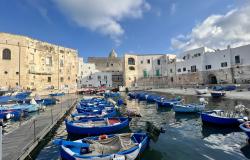Words by Lucia Cappelli - Pictures by Matteo Brogi
Abruzzo, or Abruzzi, in the plural, as it was known in former times, is still largely by-passed by mass tourism.
It is a natural link between the north and south of Italy, a land celebrated by the great poet Gabriele D’Annunzio, who was born in Pescara on the shores of the Adriatic.
The spirit of the entire region is best represented by the Casauria area. Nestling at the foot of the Majella mountain chain, with Monte Morrone, it extends for about 50 kilometres along the route of the Tiburtina Valeria, an ancient Roman road which linked the port of Ostia on the Tyrrenhian Sea with the other important landfall on the Adriatic, the city of Aternum, present-day Pescara.
Casauria is one of many place names of uncertain origin. Some say it derives from the Latin casa aurea (golden house), suggesting an especially rich and fertile area, while others maintain that it comes from cults linked to the figure of Jupiter Ourios, who ruled the winds which blow constantly through the upper valley of the River Pescara, whose source is located here.
The Abbey of San Clemente

Our journey begins at the valley’s most important spiritual centre, with a visit to the austere but majestic Abbey of San Clemente a Casauria, one of the finest examples of medieval art in Abruzzo. Probably built over the ruins of a pagan temple dedicated to Hercules, the Abbey was constructed in the 9th century for the emperor Ludovic II, grand-nephew of Charlemagne.
It is set in the greenest and most tranquil corner of Abruzzo, on the border of the ancient duchies of Benevento and Spoleto. The magnificent triple-arched portico in the façade transports the visitor into an other-worldly dimension.
Visitors are struck by the plain interior in shades of ochre, the pointed arches, the imposing marble pulpit and the paschal candelabrum in stone with polychrome inlays. But the deep mysticism which permeates this corner of Abruzzo is not confined to this Benedictine church.
Not far away, on the road towards Pietranico, stands the Oratory of Santa Maria della Croce, a wonderful sight with its stucco decoration and paintings, typical of the region’s Baroque style. A rare example of a votive church is Santa Maria delle Grazie, at Alanno, which also contains a wealth of frescoes and stucco.
Associations with Dante Alighieri

The whole area around the Abbey of San Clemente used to be dotted with a complex of towers and fortifications built to defend the River Pescara region, designed for signalling and keeping watch over the roads. Torre de’Passeri, at the centre of our itinerary, is a typical example. The strange name of the small town comes from the lookout tower which has been taken over by hundreds of birds.
The town is dominated by the castle of the Mazara family of Sulmona, and is built on the foundations of a toll station and a former prison, which still contains the messages carved by the prisoners. Originally serving as a fortress, the castle now serves as a study and research institute.
Here also is the headquarters of the ‘Casa di Dante in Abruzzo’, promoted by a group of supporters with the aim of disseminating the thoughts of Dante not only through the reading of his texts but also by raising awareness of the works of art closely linked with the poet’s writings.
The castle contains a permanent exhibition with dozens of works by contemporary artists which interpret Dante Alighieri’s ideas in a new and original way. This enthusiasm is an example of the spirit of the abruzzesi: reserved, steeped in tradition and always aware of art.
An excursion to the Majella

Our itinerary follows the River Pescara to Popoli, on the edge of the Peligna valley and at the entrance to the Tremonti gorge, between the Gran Sasso d’Italia and the Majella, famous for the quality of its waters. From here, in former times, the regions three main roads diverged, one towards the nearby Adriatic, one towards the city of L’Aquila and the third to southern Italy.
Our journey continues along the pleasant valley of the River Pescara, with the Majella massif always visible in the distance, a limestone dome which reaches a height of 2800 metres, the second highest summit in Abruzzo after the Gran Sasso d’Italia and a national park since 1995.
The Majella is the mother mountain for the people of Abruzzo, praised in songs and prayers, sometimes barren, sometimes covered in lush vegetation, scored by deep gorges and caves created by the rivers which emerge from springs.
History tells of the activities of bandits who took refuge here, recalling the events in the lives of Spartacus and his gladiators who, fleeing from Pompey, possibly found a safe haven here. Settled since the Ice Age, the area now contains fascinating fossil remains and hunting weapons of the first Italic people to occupy the area.
The Majella is also a sacred mountain, linked in antiquity with the worship of the earth goddess, Maia, and has continued to exert its fascination on those who desire to be apart from the world, like the shepherds and hermits who chose this wild place, or the celebrated St. Peter of Morrone, summoned from his mountain retreat to become Pope in 1294, when he assumed the name of Celestine V.
After only five months, unable to bear the compromised imposed by power, he renounced the papacy, this ‘great rubbish’. The event is described by Dante in his Divine Comedy.
Earthquake in Abruzzo
Unfortunately L'Aquila and other towns in Abruzzo where damaged by an earthquake on April 2009.
-
To view a list of the towns where the earthquake made most damages, please check out this link (article updated on 23 July 2009).
-
A renovation process has already started in the Abbey of S. Clemente in Casauria as described here.
-
The following video shows which parts of the Abbey were damaged.
-
If you would like to make a donation to help people to re-build towns and houses in Abruzzo, please check out
this. -
To view or take part to the discussions about Abruzzo earthquake in the Italy Community, please visit this link.
For tourist information contact
Azienda di promozione turistica di Pescara - Via Raffaele Paolucci 3, Pescara, tel. (+39) 085 4219981.
Useful websites: www.abruzzoturismo.it, www.regione.abruzzo.it/turismo, www.parcomajella.it.
Getting to Abruzzo
BY AIR: Ryanair (www.ryanair.com) flies from London Stansted directly to Pescara airport, www.abruzzo-airport.it/ita. All major airlines fly to Rome.
BY CAR: (Which can be rented at the airports): Torre de’ Passeri is about 40 km from Pescara and 190 km from Rome. It can be reached by taking the motorway A25 Pescara-Roma, exit Torre de’ Passeri-Casauria.









